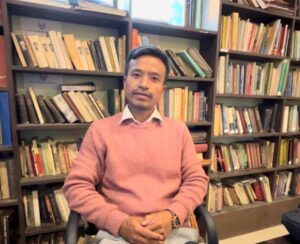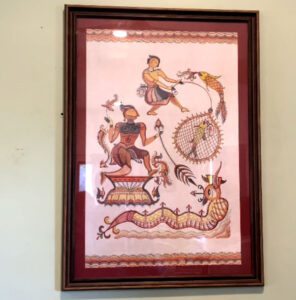At global platform Manipur is known for its rich cultural heritage through the performing arts particularly Raas Leela, Nat Sankirtan, Lai-Haraoba and Thang-Ta. But this doesn’t mean that the state doesn’t have any asset of traditional visual art.

In the field of visual art too, Manipur also has unique style of painting and it is known as ‘Subika’. This particular painting style is almost on stage of extinction and present generation are completely ignorant about. To save it from position, an artist cum academician, Yumnam Sapha Wangam Apanthoi is putting all-out effort to promote and preserve the said art work of painting
While interacting Yumnam Sapha Wangam Apanthoi who is currently working as assistant professor at department of Fine Arts in Manipur University, said that Subika painting is an illustration found in Manipuri manuscript ‘Puya’ and it is considered as earliest surviving visuals arts forms of Manipur. The painting style is being found from many ages. But just handful of people have the knowledge of this painting because Puya are not in public domain.
Despite having brief idea on Subika painting from early stage of his career on visual arts, Sapha never thought of incorporating this style of painting into his work. Later after knowing the values and significance of Subika painting, Sapha has gradually started working on said painting style while pursuing master degree.
“Cultural activist Mutua Bahadur introduced me about Subika painting for the first time in 2006 during my college days. Later after some years, my ideas on Subika painting were enlarge with the support of my friend who happened be a historian, RK Somorjit. As I did my research on art and craft of Meitei Community from University of Hyderabad, this has also inspired me more to put my hands-on in modern style of Subika painting,” Sapha recounted that how be begin Subika painting.

As an outcome of his hard work on Subika painting, his numerous illustrations on Subika are featured in books namely “And That is why” and “Feathers, Fools and Farts: Manipuri Folktales Retold”
Sapha stating about two books wherein most of his painting on modern Subika are being used, he said that ‘And that is why’ is children books retelling the Manipuri mythology with illustration. The said book is written by Somi Roy. While “Feathers, Fools and Farts: Manipuri Folktales Retold” is a folktale book authored by Somi Roy and co-authored by Thangjam Hindustani Devi. Both the books were published by Penguin Publication.
The book “Feathers, Fools and Farts: Manipuri Folktales Retold” was recently released on February 6 at National Gallery of Modern Art, New Delhi by union minister Meenakshi Lekhi.
Sapha also his profound happiness on featuring his Subika art work on these said books. “It is indeed a great privilege for me to get an opportunity to illustrate the books ‘And That is Why’ and ‘Feathers, Fools and Farts: Manipuri Folktales Retold’. I feel that my work on Subika paintings is being recognised and this help has encouraged me a lot to work more on this particular style of painting,” he said.
He said that there are six surviving manuscripts under the category of Subika namely Subika, Subika Achouba, Subika Laishaba, Subika Choudit and Thengrakhel Subika. These traditional manuscripts paintings technically signify the history, beliefs, social structure and culture of Meitei. The National Mission for Manuscripts of India has documented the illustrated manuscripts of Manipur Subika in the year 2006.
After sharing the significance of Subika painting, Sapha expressed his deep concern and longingness to promote and preserve Subika Painting style so that Manipur can also represent through visual arts.
“Comparing to other arts form like dance, drama, music and songs, visual art is still lagging behind. But this medium also play important role in society. There is a need to give emphasis even on this dying art form of Subika painting as it intricately linked with Meitei community’s cultural history,” he stated.
Recipient of Manipur State Kala Academy in 2006, Dr Yumnam Sapha Wangam Apanthoi suggested inclusion of Subika Painting in school syllabus can be one of means to promote idea of Subika Painting. He also encouraged young artist to delve into research and develop significant space of Manipuri Visual Arts at national and international level.










